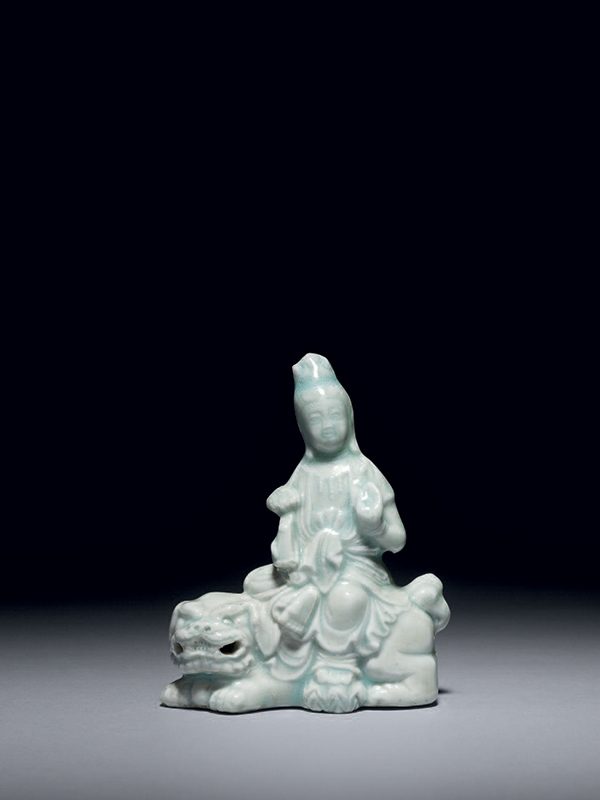Qingbai porcelain figure of Manjusri on a lion
A small porcelain figure of Manjusri seated on a lion in a pose of royal ease. Manjusri is dressed in loosely draped robes that cover most of the body and arms, and that are neatly tied up with a knotted sash and falling into rhythmic pleats. He raises his left hand up in abhaya mudra, the hand gesture indicating ‘fear not’, whilst his right hand holds a ruyi sceptre. The head is slightly downcast and his neatly arranged hair is covered by a cowl. The face has a benign expression. He is seated on the back of a recumbent lion with his right foot raised, whilst his left foot is pendant; this is known as the pose of royal ease, lalitasana. The lion has its four legs tucked underneath its body and turns its head toward the front with a well-defined, alert facial expression. The figure is covered in a transparent glaze of pale blue hue, leaving only the base unglazed and showing the fine-grained white porcelain body.
Manjusri, also known as Wenshushili or simply Wenshu in Chinese, is regarded as the Bodhisattva of Wisdom and Protector of Learning in Mahayana Buddhism. He is usually regally seated on a liondog and wears princely jewellery. Instead of holding a flaming sword in his right hand as popularly depicted in India, the sword is replaced with a ruyi scepter in Chinese and Japanese Buddhist art.[1] A comparable cizhou ceramic figure of Manjusri, dated to the Jin dynasty (1115-1234) and holding a ruyi scepter in front of his chest, was excavated in 1972 from a hoard in Handan city in Hebei province and is now in the collection of the Office for Management of Cultural Relics of Fengfeng Mining District.[2] Qingbai porcelain Buddhist figures are very rare. A much larger qingbai porcelain Guanyin figure, dated to 1251 AD according to a mark on its base, is in the collection of the Shanghai Museum.[3] A qingbai porcelain seated Buddha figure of comparable size and dated to the Yuan dynasty is in the collection of the Royal Ontario Museum.[4]
PROVENANCE
Collection of Prof. Michael Besser, London
- Welch, P. B. Chinese Art A Guide to Motifs and Visual Imagery, Tuttle publishing, 2012, p. 188
- Zhang Bai, Complete Collection of Ceramic Art Unearthed in China, Beijing, 2007, Vol. 3 (Hebei), no. 193, p. 193
- Zhongguo taoci quanji, Vol. VIII: Song part II, 19992000, pl. 202, pp. 219 and 304
- Pierson, S. ed., Qingbai Ware: Chinese Porcelain of the Song and Yuan Dynasties, Percival David Collection of Chinese Art, London, 2002, no. 118, p. 210

